Namesakes
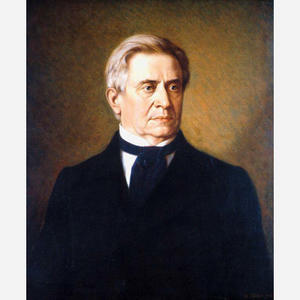 Joseph Henry (1797-1878) was a physicist and the first Smithsonian Secretary. His legacy includes a wide array of things named in his honor, including a laboratory, a professorial chair, ships, and even a mountain range. Featured below is a selection of Henry namesakes, given in chronological order. Note that the naming began during Henry's own lifetime, but continued long after.
Joseph Henry (1797-1878) was a physicist and the first Smithsonian Secretary. His legacy includes a wide array of things named in his honor, including a laboratory, a professorial chair, ships, and even a mountain range. Featured below is a selection of Henry namesakes, given in chronological order. Note that the naming began during Henry's own lifetime, but continued long after.
SCHOONER JOSEPH HENRY c. 1854
 The US Coast Survey schooner Joseph Henry is the first item identified as a Henry namesake. The superintendent of the Coast Survey, Alexander Dallas Bache, was a close friend of Henry's and named the schooner after him. The ship was used in topographical work, as were the schooners [Louis] Agassiz and Benjamin Peirce, which Bache also named after prominent American scientists of the day. The crew of the Joseph Henry surveyed the coast of Key Largo during the 1850s. The schooner shown here, Experiment, is similar to the schooner Joseph Henry.1
The US Coast Survey schooner Joseph Henry is the first item identified as a Henry namesake. The superintendent of the Coast Survey, Alexander Dallas Bache, was a close friend of Henry's and named the schooner after him. The ship was used in topographical work, as were the schooners [Louis] Agassiz and Benjamin Peirce, which Bache also named after prominent American scientists of the day. The crew of the Joseph Henry surveyed the coast of Key Largo during the 1850s. The schooner shown here, Experiment, is similar to the schooner Joseph Henry.1
CAPE HENRY c. 1855
 Henry backed several expeditions to the North Pole from the 1850s to the 1870s. One of the most famous of these was the Second Grinnell Expedition (1853–1855), organized and led by surgeon/explorer Elisha Kent Kane. Although the expedition failed in its main mission—to locate the missing polar explorer Sir John Franklin—it did gather meteorological and other scientific data while penetrating previously unexplored regions. Kane named scores of coastal bays, inlets, and other geographical features. One of these, a small projection at 79° north latitude off the coast of Ellesmere Island, he named Cape Joseph Henry (now shortened to Cape Henry and not to be confused with the Cape Joseph Henry described below). Kane thereby acknowledged Henry for giving his endorsement to the expedition in an influential letter to the secretary of the navy and for providing Kane with scientific instructions and instruments.
Henry backed several expeditions to the North Pole from the 1850s to the 1870s. One of the most famous of these was the Second Grinnell Expedition (1853–1855), organized and led by surgeon/explorer Elisha Kent Kane. Although the expedition failed in its main mission—to locate the missing polar explorer Sir John Franklin—it did gather meteorological and other scientific data while penetrating previously unexplored regions. Kane named scores of coastal bays, inlets, and other geographical features. One of these, a small projection at 79° north latitude off the coast of Ellesmere Island, he named Cape Joseph Henry (now shortened to Cape Henry and not to be confused with the Cape Joseph Henry described below). Kane thereby acknowledged Henry for giving his endorsement to the expedition in an influential letter to the secretary of the navy and for providing Kane with scientific instructions and instruments.
In the course of his explorations, Kane sketched numerous arctic scenes, from which some three hundred engravings were made and published in his two-volume narrative of the expedition. Unfortunately, Kane does not provide a sketch of Cape Henry. The engraving on the left is from Kane's depiction of icebergs near Life Boat Cove, south of Cape Henry. Here is Kane's evocative description: "A grander scene than our bay by moonlight can hardly be conceived. . . . It is a landscape such as Milton or Dante might imagine,—inorganic, desolate, mysterious. I have come down from deck with the feelings of a man who has looked upon a world unfinished by the hand of its Creator."2
HENRY ISLAND c. 1860-1861
 Isaac I. Hayes, who had served as surgeon to Kane's Second Grinnell Expedition, commanded his own arctic expedition in 1860–1861. In a lecture given at the Smithsonian shortly after his return, he expressed gratitude "to the Smithsonian Institution for the liberal support which was rendered by it to the expedition, not only by its contribution of scientific apparatus, but through the encouragement which was given towards effecting its organization by the influence of the distinguished gentleman [Joseph Henry] who is the principle executive officer of the establishment." In his book, The Open Polar Sea: A Narrative of a Voyage of Discovery Towards the North Pole, Hayes noted, "The Smithsonian furnished a good supply of barometers and thermometers, besides other apparatus not less important, and also spirits, cans, and other materials for the collection and preservation of specimens of Natural History."
Isaac I. Hayes, who had served as surgeon to Kane's Second Grinnell Expedition, commanded his own arctic expedition in 1860–1861. In a lecture given at the Smithsonian shortly after his return, he expressed gratitude "to the Smithsonian Institution for the liberal support which was rendered by it to the expedition, not only by its contribution of scientific apparatus, but through the encouragement which was given towards effecting its organization by the influence of the distinguished gentleman [Joseph Henry] who is the principle executive officer of the establishment." In his book, The Open Polar Sea: A Narrative of a Voyage of Discovery Towards the North Pole, Hayes noted, "The Smithsonian furnished a good supply of barometers and thermometers, besides other apparatus not less important, and also spirits, cans, and other materials for the collection and preservation of specimens of Natural History."
North of the cape Kane had named after Henry, Hayes discovered a sound separating Grinnell Land from Ellesmere Island. In the mouth of the sound there appeared to be two large islands; he named the southernmost one after Henry and the other one after Alexander Dallas Bache (now Bache Peninsula). Henry Island is located at 79° north latitude, and is not to be confused with the Henry Island located much further south near Cape Breton, Nova Scotia (which has no apparent connection to Joseph Henry).3
ISICHTHYS HENRYI 1862
 This specimen of fish was in the Smithsonian’s collection when the aptly named Theodore Gill described it. Gill, librarian at the Smithsonian Institution and an avid ichthyologist since his youth, believed the specimen had been sent from Liberia. In his published description of the fish, Gill stated, "I dedicate the species to my friend Prof. Henry, of the Smithsonian Institution, to whom I have been so much indebted for the privileges of studying the rich collections of the Institution, and especially of investigating the class to which the present species belongs."
This specimen of fish was in the Smithsonian’s collection when the aptly named Theodore Gill described it. Gill, librarian at the Smithsonian Institution and an avid ichthyologist since his youth, believed the specimen had been sent from Liberia. In his published description of the fish, Gill stated, "I dedicate the species to my friend Prof. Henry, of the Smithsonian Institution, to whom I have been so much indebted for the privileges of studying the rich collections of the Institution, and especially of investigating the class to which the present species belongs."
Isichthys henryi is one of the so-called electric fishes, which generate a weak electric field to detect objects in their environment. Gill probably relished the opportunity to name this particular fish after Henry, given Henry's pioneering work in electromagnetism. The holotype (the specimen from which the species was described) is preserved at the Smithsonian’s National Museum of Natural History . A modern entry on the species notes that it is a freshwater fish that inhabits the West African coastal plains of Guinea, Sierra Leone, and Liberia, and the coastal rivers of Nigeria.4
HELIODOXA JACULA HENRYI 1866
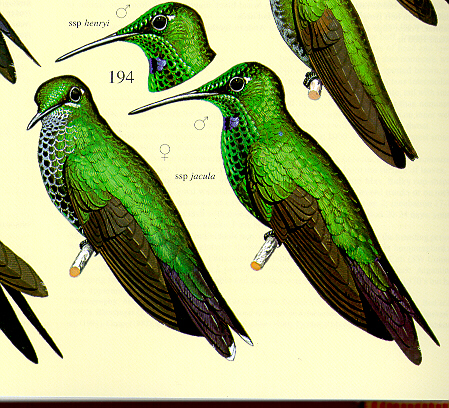 New York ornithologist George N. Lawrence first described this species of hummingbird (family Trochilidae) in 1866, naming it "in compliment to Prof. Joseph Henry." A female specimen from Costa Rica was collected in 1864 for the Smithsonian. The Institution forwarded it to Lawrence in November 1864 for him to identify. Unable to make the identification, Lawrence requested a male specimen, and the Smithsonian sent one in 1866 that had recently been collected in Costa Rica. He described and named the birds Heliodoxa jacula henryi in 1866. In 1868, Lawrence published the Catalogue of Birds of Costa Rica, the first comprehensive listing of birds from that country. The two specimens of Heliodoxa jacula henryi examined by Lawrence are preserved at the Smithsonian’s National Museum of Natural History .5
New York ornithologist George N. Lawrence first described this species of hummingbird (family Trochilidae) in 1866, naming it "in compliment to Prof. Joseph Henry." A female specimen from Costa Rica was collected in 1864 for the Smithsonian. The Institution forwarded it to Lawrence in November 1864 for him to identify. Unable to make the identification, Lawrence requested a male specimen, and the Smithsonian sent one in 1866 that had recently been collected in Costa Rica. He described and named the birds Heliodoxa jacula henryi in 1866. In 1868, Lawrence published the Catalogue of Birds of Costa Rica, the first comprehensive listing of birds from that country. The two specimens of Heliodoxa jacula henryi examined by Lawrence are preserved at the Smithsonian’s National Museum of Natural History .5
HENRY MOUNTAINS c. 1869
 Located in southeastern Utah, the Henry Mountains were one of the last-named mountain ranges in the continental United States. In 1869, geologist John Wesley Powell led a thousand mile expedition along the Green and Colorado Rivers and through the Grand Canyon in what was "the climactic event of late-nineteenth-century exploration," according to historian William Goetzmann. On this trip and subsequent ones, he encountered what few had seen before: the arid and isolated Henry Mountains, as he named them in gratitude to his friend and patron. Powell explained in his classic account, Exploration of the Colorado River of the West: "Professor Joseph Henry, the Secretary of the Smithsonian Institution, under whose direction the work was performed . . . has contributed greatly to any success which we may have had, by his instructions and advice, and by his most earnest sympathy; and I have taken the liberty to express my gratitude for his kindness, and reverence for his profound attainments, by attaching his name to a group of lofty mountains."6
Located in southeastern Utah, the Henry Mountains were one of the last-named mountain ranges in the continental United States. In 1869, geologist John Wesley Powell led a thousand mile expedition along the Green and Colorado Rivers and through the Grand Canyon in what was "the climactic event of late-nineteenth-century exploration," according to historian William Goetzmann. On this trip and subsequent ones, he encountered what few had seen before: the arid and isolated Henry Mountains, as he named them in gratitude to his friend and patron. Powell explained in his classic account, Exploration of the Colorado River of the West: "Professor Joseph Henry, the Secretary of the Smithsonian Institution, under whose direction the work was performed . . . has contributed greatly to any success which we may have had, by his instructions and advice, and by his most earnest sympathy; and I have taken the liberty to express my gratitude for his kindness, and reverence for his profound attainments, by attaching his name to a group of lofty mountains."6
CAPE JOSEPH HENRY c. 1871
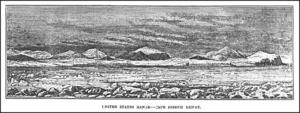 Of the dozens of polar explorations between 1850 and 1880, Charles Francis Hall's 1871 expedition on the US Navy ship Polaris has to be the one with the most movie potential. A screen version would undoubtedly portray Hall cruelly abandoning his family to pursue an obsessive quest for the North Pole, taking up with an Inuit couple to learn survival skills from arctic natives, and courageously leading a reconnoitering sledge party to the edge of the northernmost point ever seen by so-called civilized man, only to be murdered a few weeks later by a German doctor with Faustian ambitions.
Of the dozens of polar explorations between 1850 and 1880, Charles Francis Hall's 1871 expedition on the US Navy ship Polaris has to be the one with the most movie potential. A screen version would undoubtedly portray Hall cruelly abandoning his family to pursue an obsessive quest for the North Pole, taking up with an Inuit couple to learn survival skills from arctic natives, and courageously leading a reconnoitering sledge party to the edge of the northernmost point ever seen by so-called civilized man, only to be murdered a few weeks later by a German doctor with Faustian ambitions.
The point sighted by Hall just before his death was Cape Joseph Henry, located at 82° north latitude. The cape, though well short of the North Pole, would become an important depot from which subsequent expeditions would venture forth into the unknown region called "The Great Frozen Sea." The commander of a British ship attempting to explore this region in 1875 wrote: "Beyond Cape Joseph Henry all was conjecture. . . . No land of any description could be seen to the northward—nothing but the rugged pack. So formidable and compact appeared this icy barrier that it seemed to stand out bold and resolute in its strength, effectually setting at defiance the puny efforts of man to penetrate its solidity, saying, as it were, 'Thus far shalt thou go, and no farther.'"
Hall's premature death has left us with little evidence about his naming of the cape. Presumably he was grateful for Henry's critical support of the expedition, particularly for the letter of endorsement he wrote, at Hall's request, on March 18, 1870, to the chairman of the US House appropriations committee. Henry also, in his capacity as president of the National Academy of Sciences, chaired the committee that devised the expedition's scientific program. One possibly fateful decision Henry made was to choose as chief scientist for the expedition the German physicist, naturalist, and physician Emil Bessels. Although a contemporary investigation ruled that Hall died of natural causes, in 1968 Hall's biographer journeyed to the grave site to exhume Hall's body from the frozen ground. An autopsy confirmed arsenic poisoning. While the poisoning may have been unintentional, murder was a strong possibility. Hall's biographer considered Bessels a prime suspect.7
JOSEPH HENRY CHAIR OF PHYSICS 1872
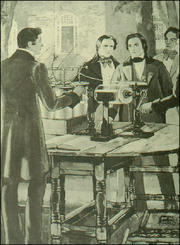 John C. Green, benefactor of the College of New Jersey, now Princeton University, honored Princeton's noted teacher and physicist by endowing this chair in 1872. Henry had been a professor of natural philosophy (physics) at Princeton from 1832 to 1848. In 1873, Princeton selected Cyrus Fogg Brackett to be the first Joseph Henry Professor of Physics. The chair has since been held by many distinguished physicists, including 1977 Nobel Prize winner Philip W. Anderson.
John C. Green, benefactor of the College of New Jersey, now Princeton University, honored Princeton's noted teacher and physicist by endowing this chair in 1872. Henry had been a professor of natural philosophy (physics) at Princeton from 1832 to 1848. In 1873, Princeton selected Cyrus Fogg Brackett to be the first Joseph Henry Professor of Physics. The chair has since been held by many distinguished physicists, including 1977 Nobel Prize winner Philip W. Anderson.
The scene at left is from a mural painted by Gifford Beal (Princeton class of 1900) in 1946, for the bicentennial of Princeton's founding. The mural, located in the lobby of the John C. Green School of Engineering, depicts Henry demonstrating electrical phenomena. The backdrop is Princeton's Philosophical Hall, where Henry taught and performed many electrical experiments, including telegraphic ones.8
HENRY MEDAL 1879

In January 1967, the Smithsonian's Board of Regents proposed to use the Henry medal to recognize distinguished service to the Institution. Since that time, recipients of the medal have included Smithsonian secretary, Charles G. Abbot ; astrophysicist, Fred Whipple; anthropologist, T. Dale Stewart; and US Vice President and Smithsonian regent, Hubert H. Humphrey. In 1997, on the occasion of the bicentennial of Henry's birth, the medal was awarded to physicist Frederick Seitz, a long-time supporter of the Joseph Henry Papers Project and chair of its advisory committee.9
TENDER JOSEPH HENRY 1880
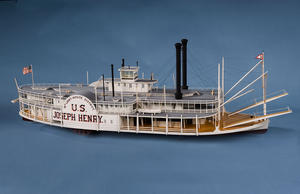 This side-wheel lighthouse tender (lighthouse service ship) was named after Henry in honor of his years of service on the US Light-House Board. Henry served on the board, without compensation, from 1852 until his death in 1878 and was chairman of its committee on experiments during these years. From 1871 to 1878, he was also chairman of the board. Henry helped introduce numerous improvements in methods of illumination and signalling, and under his leadership the Light-House Board undertook both basic and applied research in optics, thermodynamics, and acoustics. Shortly after his death, the federal government appropriated $11,000 to provide his widow with compensation for the "inestimable" value of his contribution to the nation's lighthouse system.
This side-wheel lighthouse tender (lighthouse service ship) was named after Henry in honor of his years of service on the US Light-House Board. Henry served on the board, without compensation, from 1852 until his death in 1878 and was chairman of its committee on experiments during these years. From 1871 to 1878, he was also chairman of the board. Henry helped introduce numerous improvements in methods of illumination and signalling, and under his leadership the Light-House Board undertook both basic and applied research in optics, thermodynamics, and acoustics. Shortly after his death, the federal government appropriated $11,000 to provide his widow with compensation for the "inestimable" value of his contribution to the nation's lighthouse system.
Lighthouse tenders were ships that serviced and maintained lighthouses. They were needed because lighthouses were often situated in isolated areas, where access to supplies was limited for keepers and their families. Some tenders were also used to maintain the coastal buoy system. "Through storm, darkness, and sunshine," a government official once said, lighthouse tenders "do their work for humanity without any boasting, without any advertising, with none to trumpet their praises, and with only their own sense of duty to guide them."
The Joseph Henry was one of only a few lighthouse tenders used along western rivers. It plied a 2,500-mile stretch along the Mississippi and Missouri Rivers for more than forty years.10
HENRY-BAIRD COLUMN c. 1881
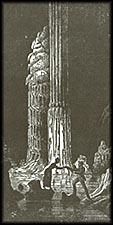 The Henry-Baird Column, also known as the Double Column, is a pair of towering stalagmites in the Giant's Hall of Luray Caverns. The caverns were discovered in Luray, Virginia, on August 13, 1878, three months after Henry's death, by locals Andrew J. Campbell and his nephew William B. Campbell, along with travelling photographer B. P. Stebbins. The discovery of one of the most interesting caves in America caused something of a sensation. It generated coverage in the major publications of the day, including Harper's Weekly, Frank Leslie's Illustrated Newspaper, the New York Herald, Century Magazine, and Scientific American. Illustrators published sketches of prominent features, and illuminated tours of the caves (lit by as many as ten thousand candles) were given on special occasions.
The Henry-Baird Column, also known as the Double Column, is a pair of towering stalagmites in the Giant's Hall of Luray Caverns. The caverns were discovered in Luray, Virginia, on August 13, 1878, three months after Henry's death, by locals Andrew J. Campbell and his nephew William B. Campbell, along with travelling photographer B. P. Stebbins. The discovery of one of the most interesting caves in America caused something of a sensation. It generated coverage in the major publications of the day, including Harper's Weekly, Frank Leslie's Illustrated Newspaper, the New York Herald, Century Magazine, and Scientific American. Illustrators published sketches of prominent features, and illuminated tours of the caves (lit by as many as ten thousand candles) were given on special occasions.
In July 1880, a party of Smithsonian officials toured the caverns at the invitation of the discoverers and proprietors. The Smithsonian party included chief clerk William J. Rhees, geologist Charles A. White, photographer T. W. Smillie, as well as two ethnologists, an archaeologist, and a chemist. Their tour lasted for two days and resulted in a twelve-page report in the Annual Report of the Smithsonian Institution for the Year 1880. Subsequently a one-thousand-pound stalactite was removed and transported to the Smithsonian.
 In 1882, Horace Hovey, considered an authority on caves, published a map of Luray Caverns in his Celebrated American Caverns. Hovey himself named most of its halls, rooms, and objects ("Christening is my business," he reportedly said). An exception was the Henry-Baird Column, which is the name used on Hovey's map. It was given this name by a small natural history society from Reading, Pennsylvania. A somewhat cryptic explanation appeared in the 1882 edition of S. Z. Ammen's History and Description of the Luray Cave, in which Ammen discusses the "Double Column" and appends this note: "Recently dedicated by the Reading Society of Natural Sciences, under the name 'Henry-Baird Column,' to the late Prof. Joseph Henry, the first Secretary, and Prof. Spencer F. Baird , the present Secretary of the Smithsonian Institution at Washington."
In 1882, Horace Hovey, considered an authority on caves, published a map of Luray Caverns in his Celebrated American Caverns. Hovey himself named most of its halls, rooms, and objects ("Christening is my business," he reportedly said). An exception was the Henry-Baird Column, which is the name used on Hovey's map. It was given this name by a small natural history society from Reading, Pennsylvania. A somewhat cryptic explanation appeared in the 1882 edition of S. Z. Ammen's History and Description of the Luray Cave, in which Ammen discusses the "Double Column" and appends this note: "Recently dedicated by the Reading Society of Natural Sciences, under the name 'Henry-Baird Column,' to the late Prof. Joseph Henry, the first Secretary, and Prof. Spencer F. Baird , the present Secretary of the Smithsonian Institution at Washington."
The Henry-Baird Column, as described by Hovey in an Encyclopedia Britannica entry in 1911, "is made of two fluted pillars side by side, the one 25 and the other 60 ft. high, a mass of snowy alabaster." As characterized by Ammen, they are "both of immense size and symmetrical in shape." A promotional article in Frank Leslie's Illustrated Newspaper in 1879 claimed that they dwarfed other columns in Giant's Hall and "will rivet the attention of tourists for hours." Today the stalagmites are known simply as the Double Column.11
JOSEPH HENRY TROLLEY 1885
 Sidney Howe Short (1858–1902) was a professor of physics and chemistry at the University of Denver in the 1880s when he laid an experimental rail line in the basement of the university building. In 1885, he constructed the Joseph Henry trolley, which he described as "a double trolley car, with five horse-power motors." His invention attracted investment capital, resulting in the organization of the Denver Tramway Company and the building of an underground conduit system designed by Short. He claimed his system was "the first electric railway commercially operated" in the United States. Although historians generally credit Frank J. Sprague with inaugurating the era of electric street cars, Short was certainly a pioneer in the field. Before he died at age 44, his work in electrical machinery had earned him more than five hundred patents and a reputation as an authority in electric railways. We do not know specifically why Short chose to honor Henry, but it was not an uncommon practice to name trolley cars (such as the Faraday and the Ampère) after scientists who discovered the principles of electromagnetism.12
Sidney Howe Short (1858–1902) was a professor of physics and chemistry at the University of Denver in the 1880s when he laid an experimental rail line in the basement of the university building. In 1885, he constructed the Joseph Henry trolley, which he described as "a double trolley car, with five horse-power motors." His invention attracted investment capital, resulting in the organization of the Denver Tramway Company and the building of an underground conduit system designed by Short. He claimed his system was "the first electric railway commercially operated" in the United States. Although historians generally credit Frank J. Sprague with inaugurating the era of electric street cars, Short was certainly a pioneer in the field. Before he died at age 44, his work in electrical machinery had earned him more than five hundred patents and a reputation as an authority in electric railways. We do not know specifically why Short chose to honor Henry, but it was not an uncommon practice to name trolley cars (such as the Faraday and the Ampère) after scientists who discovered the principles of electromagnetism.12
THE "henry" 1893
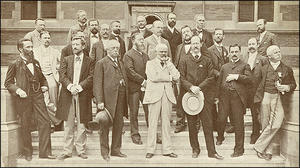 In August 1893, an International Congress of Electricians met in Chicago during the World's Columbian Exposition. Scientists and engineers at the congress adopted names and agreed on definitions for eight units of electrical measure: the ohm, the ampere, the volt, the coulomb, the farad, the joule, the watt, and the henry. The motion to adopt the henry, the only unit named after an American, came from the leader of the French delegation, physicist Éleuthère Élie Nicolas Mascart. The henry was defined as "the induction in a circuit when the electro-motive force induced in this circuit is one international volt, while the inducing current varies at the rate of one ampère per second."13
In August 1893, an International Congress of Electricians met in Chicago during the World's Columbian Exposition. Scientists and engineers at the congress adopted names and agreed on definitions for eight units of electrical measure: the ohm, the ampere, the volt, the coulomb, the farad, the joule, the watt, and the henry. The motion to adopt the henry, the only unit named after an American, came from the leader of the French delegation, physicist Éleuthère Élie Nicolas Mascart. The henry was defined as "the induction in a circuit when the electro-motive force induced in this circuit is one international volt, while the inducing current varies at the rate of one ampère per second."13
SS JOSEPH HENRY 1943
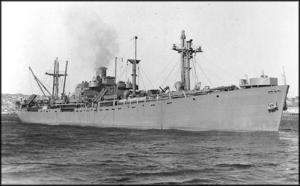 The SS Joseph Henry was a Liberty ship built in 1942–1943 by the Kaiser Company in Vancouver, Washington, and completed by the Oregon Ship-Building Corporation of Portland, Oregon. The launch date was January 23, 1943. A total of 2,710 Liberty ships were constructed during World War II in response to the urgent need for mass-produced cargo ships to supply troops with food and war materials. According to one study of the Liberty ship program, "The original style of nomenclature adopted for the emergency vessels was the bestowing upon them the names of persons notable in the history and culture of America."14
The SS Joseph Henry was a Liberty ship built in 1942–1943 by the Kaiser Company in Vancouver, Washington, and completed by the Oregon Ship-Building Corporation of Portland, Oregon. The launch date was January 23, 1943. A total of 2,710 Liberty ships were constructed during World War II in response to the urgent need for mass-produced cargo ships to supply troops with food and war materials. According to one study of the Liberty ship program, "The original style of nomenclature adopted for the emergency vessels was the bestowing upon them the names of persons notable in the history and culture of America."14
JOSEPH HENRY ELEMENTARY SCHOOL 1958
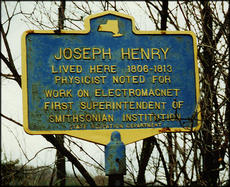 The Joseph Henry Elementary School is located just outside the village of Galway, New York, where Henry lived for part of his childhood and adolescence. The school opened in 1958 and was named in honor of the village's most illustrious denizen. A roadside plaque by Henry's childhood home states, "Joseph Henry: Lived Here 1806–1813, Physicist noted for work on Electromagnet, First Superintendent of Smithsonian Institution." The exact years Henry lived in Galway cannot be confirmed; a surviving letter to his parents places him there at least by 1808 and evidence suggests he remained there until 1814 or 1815.15
The Joseph Henry Elementary School is located just outside the village of Galway, New York, where Henry lived for part of his childhood and adolescence. The school opened in 1958 and was named in honor of the village's most illustrious denizen. A roadside plaque by Henry's childhood home states, "Joseph Henry: Lived Here 1806–1813, Physicist noted for work on Electromagnet, First Superintendent of Smithsonian Institution." The exact years Henry lived in Galway cannot be confirmed; a surviving letter to his parents places him there at least by 1808 and evidence suggests he remained there until 1814 or 1815.15
JOSEPH HENRY LABORATORIES OF PHYSICS c. 1966
 The physics department of Princeton University gave the name Joseph Henry to its laboratory facilities, which by 1970 would include those located in the newly built Jadwin Hall as well as in Palmer Hall and the Elementary Particles Laboratory. Henry had been professor of natural philosophy at Princeton from 1832 to 1848. Although his tenure as Secretary of the Smithsonian began in 1846, he retained his position at Princeton until June 1848. For many years thereafter his former colleagues tried to convince him to return to the school.
The physics department of Princeton University gave the name Joseph Henry to its laboratory facilities, which by 1970 would include those located in the newly built Jadwin Hall as well as in Palmer Hall and the Elementary Particles Laboratory. Henry had been professor of natural philosophy at Princeton from 1832 to 1848. Although his tenure as Secretary of the Smithsonian began in 1846, he retained his position at Princeton until June 1848. For many years thereafter his former colleagues tried to convince him to return to the school.
Statues by Daniel Chester French of Henry and Benjamin Franklin are fittingly paired at the front entrance of Palmer Laboratory (which is now part of the Frist Campus Center). Henry was often compared to Franklin because of their pioneering experiments with electricity.16
JOSEPH HENRY PRESS 1993
 An imprint of the National Academy of Sciences, the Joseph Henry Press was created to improve public understanding of science by making books on science, technology, and health more widely available. Henry was one of the original members of the academy and its second president. The academy chose to name the press after him because of his "renaissance spirit" and his impact on American science.17
An imprint of the National Academy of Sciences, the Joseph Henry Press was created to improve public understanding of science by making books on science, technology, and health more widely available. Henry was one of the original members of the academy and its second president. The academy chose to name the press after him because of his "renaissance spirit" and his impact on American science.17
FURTHER RESOURCES
Frank Millikan, "Henry Namesakes," Smithsonian Institution Archives.
Frank Millikan, "Henry Namesakes Notes," Smithsonian Institution Archives.
Ellen Alers, "Road trip!," Bigger Picture (blog), Smithsonian Institution Archives, June 29, 2011.
FOOTNOTES
1 United States Coast Survey, Report of the Superintendent of the Coast Survey Showing the Progress of the Survey during the Year 1854 (Washington, DC: Robert Armstrong, Public Printer, 1855), 65; United States Coast Survey, Report of the Superintendent of the Coast Survey Showing the Progress of the Survey during the Year 1855 (Washington, DC: Robert Armstrong, Public Printer, 1856), 76; United States Coast Survey, Report of the Superintendent of the Coast Survey Showing the Progress of the Survey during the Year 1856 (Washington, DC: Robert Armstrong, Public Printer, 1856), 64; Hugh Richard Slotten, Patronage, Practice, and the Culture of American Science: Alexander Dallas Bache and the US Coast Survey (Cambridge, MA: Cambridge University Press, 1994), 153. Return to text
2 Margaret Elder Dow, "Elisha Kent Kane," in Dictionary of American Biography (New York, NY: Charles Scriber's Sons, 1935, 1936); Joseph Henry and Alexander Dallas Bache to John Pendleton Kennedy, 1 December 1852, in The Smithsonian Years: January 1850–December 1853, Marc Rothenberg and Kathleen W. Dorman, eds., vol. 8 of The Papers of Joseph Henry (Washington, DC: Smithsonian Institution, 1998), 408–410; Geographic Names Database, Prince of Wales Northern Heritage Centre ; Elisha Kent Kane, Arctic Explorations: The Second Grinnell Expedition in Search of Sir John Franklin, 1853,'54,'55, vol. 2 (Philadelphia, PA: Childs & Peterson, 1857), 56–57, 385. Return to text
3 I. I. Hayes, "Lecture on Arctic Explorations," Annual Report of the Board of Regents of the Smithsonian Institution for the Year 1861 (Washington, DC: Government Printing Office, 1862), 149, 157; Isaac I. Hayes, "Physical Observations in the Arctic Seas," in Smithsonian Contributions to Knowledge, vol. 15 (Washington, DC: Smithsonian Institution, 1867), x; I.I. Hayes, The Open Polar Sea: A Narrative of a Voyage of Discovery Towards the North Pole (New York, NY: Hurd and Houghton, 1867), 10; Albert Hastings Markham, The Great-Frozen Sea: A Personal Narrative of the Voyage of the "Alert" During the Arctic Expedition of 1875–6 (London: C.K. Paul, 1894), 64; Geographic Names Database . Return to text
4Proceedings of the Academy of Natural Sciences of Philadelphia 14 (September 1862): 444–445. Additional information on the specimen supplied by David G. Smith, museum specialist in the Department of Vertebrate Zoology, National Museum of Natural History, Smithsonian Institution; Species Summary for Isichthys henryi . Image of Isichthys henryi obtained from Photographs and Preliminary Identifications . Biographical entries on Gill in the Dictionary of Scientific Biography and Spencer Baird and Ichthyology at the Smithsonian, 1850–1900 . Return to text
5 George N. Lawrence, "Heliodoxa Henryi," Annals of the Lyceum of Natural History of New York 8 (December 1866): 402; Clark A. Elliott, Biographical Dictionary of American Science (Westport, CT: Greenwood Press, 1979), 151; M. A. Carriker, "An Annotated List of the Birds of Costa Rica," reprinted from the Annals of the Carnegie Museum 6, nos. 2–4 (1910): 358–360; Heliodoxa jacula henryi image, Josep del Hoyo, Andrew Elliott, and Jordi Sargatal, eds., Handbook of the Birds of the World, vol. 5 (Barcelona: Lynx Edicions, 1999), plate 61, no. 194. Return to text
6 William H. Goetzmann, Exploration and Empire: The Explorer and the Scientist in the Winning of the American West (New York: Knopf, 1966), 541, 534–536; John Wesley Powell, Exploration of the Colorado River of the West and its Tributaries: Explored in 1869, 1870, 1871, and 1872, Under the Direction of the Secretary of the Smithsonian Institution (Washington, DC: Government Printing Office, 1875), xi; William Culp Darrah, Powell of the Colorado (Princeton, NJ: Princeton University Press, 1951), 78–82, 89, 93–95, 99, 105–107, 112, 152, 205, 215, 259; Joseph Henry to James A. Garfield, 20 April 1868, Outgoing Correspondence, Office of the Secretary, Record Unit 33 , Smithsonian Institution Archives; Annual Report of the Board of Regents of the Smithsonian Institution for the Year 1871 (Washington, DC: Government Printing Office, 1873), 26; Annual Report of the Board of Regents of the Smithsonian Institution for the Year 1875 (Washington, DC: Government Printing Office 1876), 17; G. K. Gilbert, Report on the Geology of the Henry Mountains (Washington, DC: Government Printing Office, 1877), 1. Return to text
7 Samuel Willard Crompton, "Charles Francis Hall," in American National Biography, ed. John A. Garraty and Mark C. Carnes (New York, NY: Oxford University Press, 1999); Trevor H. Levere, Science and the Canadian Arctic: A Century of Exploration, 1818–1918 (Cambridge, UK: Cambridge University Press, 1993), 248–253; Annual Report of the Board of Regents of the Smithsonian Institution for the Year 1873 (Washington, DC: Smithsonian Institution, 1874), 37–38; Markham, The Great-Frozen Sea, 127; G. S. Nares, Narrative of a Voyage to the Polar Sea During 1875–6, vol. 1, (London: S. Low, Marston, Searle & Rivington, 1878), 130, 169, 252–253, 301–302, 326; Joseph Henry to H.L. Dawes, 18 March 1870, Office of the Secretary, Outgoing Correspondence, Record Unit 33 , Smithsonian Institution Archives; Joseph Henry, 11 and 18 March 1870, Henry Desk Diary, Joseph Henry Collection, Record Unit 7001 , Smithsonian Institution Archives; Chauncey C. Loomis, Weird and Tragic Shores: The Story of Charles Francis Hall, Explorer (New York: Knopf, 1971), 251–254, 279–281, 337–354; Emil Bessels, Scientific Results of the United States Arctic Expedition: Steamer Polaris, C. F. Hall Commanding (Washington, DC: Government Printing Office, 1876); Charles P. Daley, 6 December 1876, Office of the Secretary, Incoming Correspondence, Record Unit 26 , Smithsonian Institution Archives; Geographic Names Database . Return to text
8 Alexander Leitch, ed., A Princeton Companion (Princeton, NJ: Princeton University Press, 1978), 64, 160, 248; Charles G. Osgood, Lights in Nassau Hall: A Book of the Bicentennial, Princeton, 1746–1946 (Princeton, NJ: Princeton University Press, 1951), 114. Return to text
9 William Barber to Spencer F. Baird, 15 May 1878; and William Barber to Miss [Mary?] Henry, 9 June 1879, Joseph Henry Collection, Record Unit 7001 , Box 39, Smithsonian Institution Archives; Board of Regents Meeting, 25 January 1967, Office of the Secretary, Record Unit 99 , Box 1, Smithsonian Institution Archives; David Ferry, trans., The Odes of Horace (New York, NY: Farrar, Straus, and Giroux, 1997), 64–65. Return to text
10 The model pictured here mistakenly indicated the ship belonged to the sixteenth lighthouse district; it actually served the fifteenth district. Marc Rothenberg and Kathleen W. Dorman, eds., The Smithsonian Years: January 1850–December 1853, vol. 8 of The Papers of Joseph Henry (Washington, DC: Smithsonian Institution, 1998), xxxiii–xxxiv; John Rodgers to Harriet Henry, 5 July 1878, Rhees Collection, RH 4221, Huntington Library; Senate Executive Document No. 94, 45th Congress, 2d Session, 2; "U.S. Coast Guard Cutter, Fir," National Maritime Initiative, National Park Service , June 25, 1999; Arnold Burges Johnson, The Modern Light-House Service (Washington, DC: Government Printing Office, 1890), 42–43; George R. Putnam, Lighthouses and Lightships of the United States (Boston, MA: Houghton Mifflin Company, 1917), 213; Annual Report of the Light-House Board for the Fiscal Year Ended June 30, 1886 (Washington, DC: Government Printing Office, 1886), 106–107. Return to text
11 Horace C. Hovey, "The Caverns of Luray," in Celebrated American Caverns (Cincinnati, OH: R. Clarke & Company, 1882), map facing 163, 164–167, 172, 179; "Report of a Visit to the Luray Cavern, in Page County, Virginia, Under the Auspices of the Smithsonian Institution, July 13 and 14, 1880," Annual Report of the Board of Regents of the Smithsonian Institution for the Year 1880 (Washington, DC: Government Printing Office, 1881), 449–460; Russell H. Gurnee, Discovery of Luray Caverns, Virginia (Closter, NJ: Gurnee, 1978), 45, 52, 69, 72–73, 76, 77, 86, 88; S. Z. Ammen, History and Description of the Luray Cave (Baltimore, MD: J.W. Borst & Company, 1882), 31; "Luray Cavern," Encyclopedia Britannica, ed. Hugh Chisolm (New York, NY: Encyclopedia Britannica, 1911), 127–128. Image of Henry-Baird Column taken from Frank Leslie's Illustrated Newspaper, 1 February 1879, 400; W. J. Hoffman to Joseph Henry, 4 February 1869, Office of the Secretary, Incoming Correspondence, Record Unit 26 , Smithsonian Institution Archives; Joseph Henry to R. S. Turner, [11?] February 1870, Outgoing Correspondence, Record Unit 33 , Smithsonian Institution Archives; Frank Kimball to Joseph Henry, 29 May 1871, Incoming Correspondence, Record Unit 26 , Smithsonian Institution Archives; Hovey, Celebrated Caverns, 186; "Obituary Notice of Dr. G. W. Hawes," Annual Report of the Board of Regents of the Smithsonian Institution for the Year 1882 (Washington, DC: Government Printing Office, 1884), 158–160. Return to text
12 Carl W. Mitman, "S. H. Short," Dictionary of American Biography (New York, NY: Charles Scribner’s Sons, 1932, 1933); S. H. Short, "The First Electric Railroad," St. Louis Daily Globe-Democrat, 14 May 1899, Section 3, 10; George K. Bradley, "Thomas A. Edison, Leo Daft, Edward M. Bentley, Walter H. Knight, and Others Who Were Pioneer Electric Railway Inventors," in Pioneers of Electric Railroading: Their Story in Words and Pictures, ed. John R. Stevens (New York, NY: Electric Railroaders’ Association, 1991), 54, 81; George W. Hilton and John F. Due, The Electric Interurban Railways in America (Stanford, CA: Stanford University Press, 1960), 6–7. Return to text
13Report of the Action of the International Electrical Congress held in Chicago, August, 1893, in the Matter of Units of Electrical Measure, 1–4, Joseph Henry Collection, Record Unit 7001 , Box 27, Smithsonian Institution Archives; Annual Report of the Board of Regents of the Smithsonian Institution to July, 1893 (Washington, DC: Government Printing Office, 1895), 10; T.C. Mendenhall, "The Henry," Annual Report of the Board of Regents of the Smithsonian Institution for the Year ending June, 1894 (Washington, DC: Government Printing Office, 1896), 141, 143, 152; Robert H. Stuewer, “Eleuthere Elie Nicolas Mascart,” Dictionary of Scientific Biography (New York, NY: Charles Scribner’s Sons, 1974). Photograph of delegates to the congress from Proceedings of the International Electrical Congress held in the City of Chicago: August 21st to 25th, 1893 (New York: American Institute of Electrical Engineers, 1894), frontispiece. Return to text
14 L. A. Sawyer and W. H. Mitchell, The Liberty Ships (Cambridge, MD: Cornell Maritime Press, 1970), 13–16, 86–88. Return to text
15 "Galway: Yesterday and Today," Galway Preservation Society, 1988; Albert E. Moyer, Joseph Henry: The Rise of an American Scientist (Washington, DC: Smithsonian Institution Press, 1997), 17, 20. Return to text
16 Alexander Leitch, ed., A Princeton Companion (Princeton, NJ: Princeton University Press, 1978), 248, 277, 351; Frank Shoemaker, interviewed by Frank Millikan, Phone Interview, 11 August 1999. When the widow of Stanley Palmer Jadwin died in 1964, the bulk of her estate went to Princeton (some $27 million). A new physics building was constructed shortly thereafter and named Jadwin Hall in honor of Stanley Palmer Jadwin. The physics department had suggested the building be named after Joseph Henry. When the university administration chose to honor the benefactor, the department named its complex of laboratories after Henry. Return to text
17 1993 press release, Joseph Henry Press; communication from Stephen Mautner, executive director of the press, July 1999. Return to text
